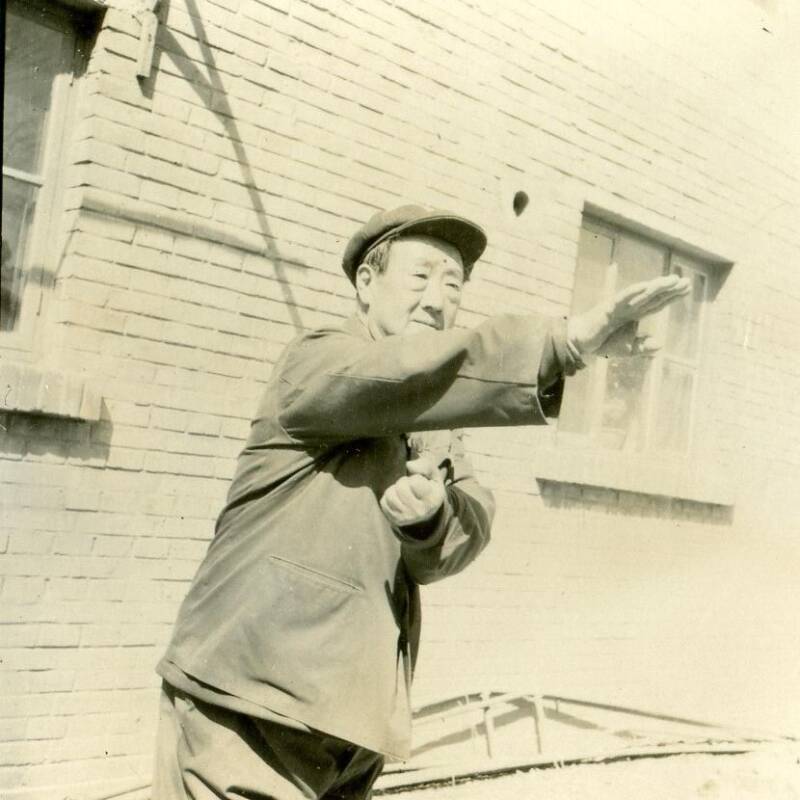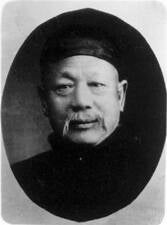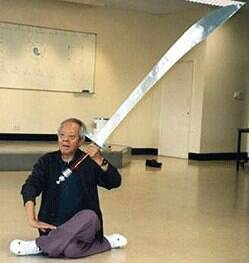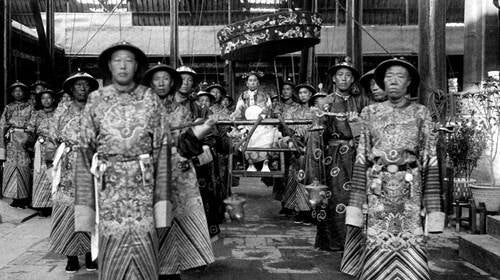Bagua Zhang (八卦掌) Eight Diagram Palm
The Art of Change — Circular Power, Spiraling Intent
“Bagua Zhang is the science of becoming unavailable.”
— Shifu W. C. Bey
Various Bagua Masters, Beijing 1993
Circle Walking — The Core
Dong was quoted as saying:
“Training martial arts is not as good as walking the circle.”
His students recorded that Dong combined:
-
Taoist circle-walking meditation
-
Internal energy & spirit training
-
Practical combat application
Historical text confirms that Dong combined martial arts with Daoist meditation practices involving keeping the mind empty while walking the circle.
Teaching at the Imperial Mansion
Dong eventually became a martial instructor in the palace of Prince Su, a high-ranking Manchu noble.
From this position, he met and trained elite fighters already highly skilled in other systems.
Those who could not demonstrate enough skill were rejected; those who proved themselves were taught Bagua.
As a result, Dong’s first generation of disciples were already martial experts, which is why each lineage of Bagua developed differently.
The Branches That Followed
From Dong came three of the most influential branches — the same ones we train:
-
Yin Style Bagua (阴派八卦掌)
-
Disciple: Yin Fu (1840–1909)
-
Known for: animal systems and striking structure
-
Transmission to us: Yin Fu → Men Baozhen → Dr. Xie Peiqi → W.C. Bey
-
-
Magui Bagua (马贵八卦掌)
-
Disciple: Ma Gui (1852–1942)
-
Known for: heavy circle power, deep frames, coiling root
-
Transmission to us: Ma Gui → Li Shao’an → Liu Wanchuan → Yu Zhiming → Li Baohua → W.C. Bey
-
-
Gao Yisheng Bagua (高义盛八卦掌 / Gao Bagua)
-
Disciple of Cheng Tinghua: Gao Yisheng (1866–1951)
-
Known for: 64 Post-Heaven Palms (linear + circular integration)
Gao studied “pre-heaven” Bagua and then later learned “post-heaven” skills from a Taoist descendant of Dong’s teacher.
-
Legacy
Dong Haichuan didn’t just teach a fighting art — he transmitted a system of transformation.
Bagua is the art of change.
It trains the ability to disappear, reappear, and control space.
His students carried Bagua across China:
-
Yin Fu taught in the Imperial Guard
-
Ma Gui spread Bagua through Beijing’s fighting circles
-
Cheng Tinghua introduced Bagua to martial artists from Xingyi, Shuai Jiao, and others
Because each student entered with different backgrounds, Bagua evolved into distinct branches — yet every branch traces back to circle walking with Dong Haichuan.
Bagua Today — Continuing the Thread
Our school inherits the three major lines:
-
Yin Style Bagua
-
Magui Bagua
-
Gao Yisheng Bagua
All passed through Shifu W. C. Bey, who transmits these systems directly to Shifu Louis Diaz Ali El and the Golden Thread Internal School.
We do not practice Bagua for the circle.
We walk the circle so we can transform.

Ma Gui (马贵) — Grandmaster of the Magui Bagua Lineage
Early Life & Martial Background
Ma Gui (also given as Ma Shiqing 马世卿; born around 1847–1857, died 1941) grew up in Beijing, with family roots in Laishui County, Hebei Province. Wikipedia+2Wikipedia+2
Even as a youth he practiced rigorous arts such as Tian Gang Quan (天罡拳) and Shaolin “Eighteen Arhat Fist” sets. ycgf.org+1
Becoming a Disciple of Bagua
Ma Gui began formal Bagua training under Yin Fu — the senior disciple of Dong Haichuan. Later, he also trained directly under Dong Haichuan, thereby receiving deep transmission. ycgf.org+1
Despite his small stature, he became formidable: one record says that while patrolling the palace grounds his repeated kicking of foundation stones caused visible damage. ycgf.org
He acquired nicknames such as “Mu Ma” (木马 – “Lumber Ma”) because of his lumber business, and “Tie Ge Bo Ma” (铁胳膊马 – “Iron-Arm Ma”) for his striking power. imperialcombatarts.com+1
Palace Service & Legacy
Ma Gui served as an imperial bodyguard under Prince Su’s household and later taught in the palace of Prince Duan. His reputation for martial skill and rigorous training made him highly respected.
Notably, in 1930 he erected a commemorative stele at Dong Haichuan’s tomb, reaffirming the continuity of the Bagua lineage.
Style & Contributions
Ma Gui’s branch — often referred to as Magui Bagua (马贵八卦掌) — is characterized by:
-
Deep, rooted postures and low stepping.
-
Heavy emphasis on circular stepping, coiling force, and spiral power.
-
Training drills that include body-hardening, strong leg conditioning, and dynamic whole-body power.
His teaching remained traditional and rigorous; he once stated: “Anyone who feels the art is too difficult to learn should not be taught in the first place.” - Ma Gui Bagua’s most striking characteristic is the slow and stable circle-walking that develops lower leg strength, qi, and blood flow, and whole body power. The body develops to resemble Dong Haichuan and Ma Gui – a thick trunk and back with well developed dantian, firm wrists and ankles, powerful legs and arms, rosy complexion, and calm expression. When practising techniques, footwork is clean and quick, always using koubu and baibu. The system also emphasises horse stance training to develop useable whole body power in techniques, and specific fast stepping with techniques practices that develop the coordination for the application of this power. Training this system develops your health and martial ability simultaneously. It is not a performance based style.
Relevance to Our Curriculum
For the Golden Thread Internal School, Ma Gui’s system anchors the circle-power branch of Bagua we teach. It complements the Yin Style striking branch and the Gao Yisheng linear-circular integration branch, giving students a complete internal-martial map.
“Ma Gui taught that when the circle becomes root, stepping becomes invisibility, and your body becomes the axis of change.”
— Shifu W. C. Bey

Li Shao’an (李绍安)
First Successor of Ma Gui Bagua — The Keeper of the Original Deep-Frame Method
Li Shao’an (dates historically estimated: late 1800s–mid 1900s) was the first formal lineage inheritor of the Ma Gui branch of Baguazhang. After the passing of Ma Gui (1852–1942), Li Shao’an became the steward of the system — not to promote it publicly, but to preserve its purity.
Where many branches of Bagua in Beijing began integrating external influences (martial exchange, competition training, modern sport methods), the transmission from Ma Gui to Li Shao’an remained private, uncompromised, and methodical.
What defined Li Shao’an’s transmission:
-
Deep Stance Structure (深架子功) — building unshakable root and tendon strength
-
Heavy Circle-Walking (重圈功) — training endurance, fascia integration, and power through change
-
Internal Spiral Coiling (螺旋劲) — force generated through the kua, spine, and fascia, not muscle
Li Shao’an preserved the original training sequence:
Root → Frame → Change
He was respected not just for his skill, but for his refusal to dilute the art. In a time when many internal systems were forced to adapt for public teaching, Li Shao’an kept Ma Gui Bagua private-door (关门传) — taught only to those who demonstrated loyalty, discipline, and moral integrity.

Liu Wanchuan (刘万川)
Second Successor of Ma Gui Bagua — The Hidden Strength of the Deep-Circle System
Liu Wanchuan (circa early 1900s–late 1900s) was the second-generation lineage successor of the Ma Gui school of Baguazhang. He inherited the system from Li Shao’an, who was the direct disciple and chosen successor of Ma Gui, one of Dong Haichuan’s private-door students.
Liu Wanchuan was known throughout Beijing for a type of power few people understood — frame-pressure strength (架子力). His Bagua was not fast or showy. It was dense, heavy, and rooted, with every step sinking into and gripping the earth.
What defined Liu Wanchuan’s skill:
-
Iron-root circle walking (铁根走圈)
His circle-walking training emphasized endurance and unbreakable structure. Students reported that training with him was like walking against gravity. -
Deep Frame Conditioning (深架子)
He insisted that students develop internal strength before learning the palm changes.
“First build the frame, then the change.” -
Application Without Clash
Liu emphasized taking the opponent’s center without collision:“If you meet force, you fail. If you move first, you reveal. If you disappear, you win.”
Private Door Transmission
Like his teacher Li Shao’an, Liu Wanchuan taught very few people, and never commercialized the art. The Ma Gui system remained quiet, unknown to the public martial world, while other Bagua lineages became widely promoted.

Yu Zhiming (于志明)
Third Successor of Ma Gui Bagua — The Gatekeeper Before Modern Disclosure
Yu Zhiming (mid-1900s–early 2000s) was the third-generation lineage successor in the Ma Gui branch of Baguazhang. He inherited the system directly from Liu Wanchuan, who received transmission from Li Shao’an, the first successor of Ma Gui.
Yu Zhiming served as the critical bridge between the old world and the modern era, maintaining the private-door teachings that had been closely guarded through three generations.
What defined Yu Zhiming’s transmission
-
Precision without compromise — techniques were exact, not “interpreted”
-
Structure over aesthetics — stance depth, root, and coiling came first
-
Few students, deep transmission — quality over quantity
Yu Zhiming’s approach was direct and uncompromising:
“If it can be explained quickly, it is shallow.
If it takes a lifetime, it is Bagua.”
He continued the non-commercial tradition of the Ma Gui school:
no performances, no public demonstrations, no dilution.
Training Method
Yu Zhiming emphasized:
-
Long-duration circle walking — neurological and fascia conditioning
-
Coiling kua rotations — deep pelvic-hip integration
-
Frame pressure training — the ability to generate force without visible muscular effort
Students trained:
-
Root first
-
Power second
-
Technique last
This ensured that anyone who received transmission embodied structure before movement, the core principle of Ma Gui Bagua.

Li Baohua (李保华)
Preserver of the Ma Gui Bagua System — The Deep Frame, Heavy Root School
Li Baohua (1965–2022) was the final generation inheritor responsible for bringing the Ma Gui Bagua lineage out of secrecy and into the modern world. A direct disciple of Yu Zhiming, and the lineage descendant of Liu Wanchuan, Li Shao’an, and ultimately Ma Gui (1852–1942), he represented a branch of Bagua that remained almost completely untouched by commercial influence.
Where Yin Style Bagua focuses on striking logic and animal methods, Ma Gui Bagua is defined by depth:
-
Deep frames
-
Heavy stepping power
-
Integrated spiraling of fascia and bone
-
Continuous circle-walking without loss of structure
Li Baohua emphasized that Ma Gui Bagua is not “dance-like,” not for show, and not diluted.
It is combat structure and whole-body method, trained from the ground up without shortcuts.
He taught the original training progression:
-
Deep circle-walking — build the frame and neurological endurance
-
Power generation from the kua (胯) — root → turn → release
-
Palm transformations — entering and finishing without resistance
Li Baohua was known for his intellect as much as his skill.
He brought clarity to Ma Gui’s famously private method and organized it into a structure that could be passed on without losing essence.
He stated:
"Do not seek more movements — seek more depth."
Li Baohua believed that Bagua Zhang is not a list of techniques, but a way of moving, a way of thinking, and a way of expressing power through change. His teaching ensured that Ma Gui Bagua would not disappear into history, but transform through those worthy to carry it.
Today, the Ma Gui lineage continues through those who received direct instruction, including Shifu W. C. Bey, who transmits this system to the next generation.

History of the Founder of Bagua-Zhang —
Dong Haichuan (董海川 / Tung Hai Chuan)
The Man Who Made Circles Walk
Dong Haichuan (董海川, c.1813–1884) is recognized by nearly every major lineage as the founder or transmitter of Baguazhang (八卦掌) — “Eight Trigram Palm.”
He was born in Hebei Province and spent his early life traveling throughout China, seeking instruction from skilled martial artists and Daoist practitioners.
According to historical stele inscriptions and lineage records, Dong learned circle-walking and internal cultivation from a Daoist while traveling in the southern mountains. These inscriptions — erected by his senior disciple Yin Fu — are considered the most authoritative historic sources and state that Dong learned methods involving Qi cultivation, spirit training, stepping patterns, advancing and retreating.
They also emphasize that Dong never claimed to have invented Bagua, but that he brought together an internal walking practice with martial method and refined it.
One passage describes him traveling widely, visiting mountains, studying with a “yellow-capped Daoist,” becoming adept in boxing, and developing what would become the Bagua method.

Yin Fu
Early Life & Martial Beginnings
Yin Fu (born 1840 or 1841 in Zhanghuai Village, Jixian, Hebei Province) began his martial training in humble circumstances. His family was modest, and in his youth, he already supplemented his income by street work—selling sesame cakes while continuously practicing martial styles such as Tantui (弹腿) and Shaolin “Eighteen Arhat Fist” systems.
Meeting Dong Haichuan & Apprenticeship
In the 1860s, while the legendary Dong Haichuan (董海川) was serving as instructor at the palace of Prince Su in Beijing, Yin Fu—already a dedicated martial artist—sought him out. After a test fight, Dong accepted Yin as a disciple. Over a prolonged apprenticeship—reportedly ten years or more—Yin trained alongside Dong, including a period in Inner Mongolia where they served collection duties for the prince’s estate and practiced together continuously.
Becoming the Palace Guardian
Upon Dong’s retirement from the palace role, Yin Fu succeeded him as supervisor of the palace guards, and subsequently served the Empress Dowager and Emperor Guangxu within the Forbidden City. His close association with the court earned him the nickname of the “Palace Bagua” teacher. Yin Style Bagua Combatives+1
Formulating Yin-Style Bagua & Its Distinct Features
Yin Fu took the material he learned from Dong Haichuan and refined it into what became known as Yin-Style Bagua Zhang (阴派八卦掌). This style emphasizes:
-
Striking while moving, with circle-walking deeply integrated.
-
A set of eight animal systems (in some lineages) each aligned to one trigram of the I Ching.
-
Striking, kicking, joint control and Qinna developed through moving drills, fixed postures and changing footwork.
-
A demanding internal system that aimed to combine martial efficacy with internal cultivation.
Yin Fu’s Bagua is often called the “Ox-Tongue Palm” (牛舌掌) due to the shape and angle of his palm method.
Key Disciples & Legacy
His most notable student was Men Baozhen, followed by others such as Li Baosen, Gong Baotian, and more. His branch further disseminated through Dr Xie Peiqi and beyond.
Yin Fu passed away on 28 June 1909. Upon his death, his students and successors erected memorial tablets in Beijing, solidifying his place as one of the foundational pillars of Bagua Zhang.
For our lineage at the Golden Thread Internal School, Yin Fu’s contribution represents the striking branch of Bagua—deeply martial, richly internal, and uniquely adapted for skilled practitioners.
His version preserves the circle-walking method and transforms it into powerful expression—exactly the kind of transmission we honor.
“Yin Fu walked the circle so long it ceased to be motion—and became presence.”
— Shifu W. C. Bey
Closing Note
By situating Yin Fu clearly in our curriculum page, we anchor the Yin Style Bagua branch you teach—ensuring students understand not only the technical lineage, but the historical and philosophical pedigree.

Men Baozhen (门宝珍)
Keeper of Yin Style Bagua — The Hidden Door of the Imperial Bodyguard Method
Men Baozhen (1853–1912) was one of the few disciples who received private-door transmission of Bagua Zhang directly from Yin Fu, Dong Haichuan’s top disciple and bodyguard instructor to the Qing Imperial Court.
Where many trained Bagua as a martial art, Men Baozhen trained it as a profession — a combat system designed for real-time violence, multiple attackers, and mission-focused efficiency.
Men was known for:
-
razor-accurate striking,
-
minimalist footwork,
-
and cold, emotionless execution.
He preserved Yin Fu’s original eight animal fighting system (八大兽形) — Lion, Snake, Bear, Dragon, Phoenix, Rooster, Unicorn, and Monkey — each containing its own structure, attacking logic, and strategy. This is the source of what is today called Yin Style Bagua.
Men Baozhen did not seek followers.
He sought heirs.
He passed the complete system only to a small number of students — the most important being Dr. Xie Peiqi, who became the modern inheritor responsible for preserving Yin Style Bagua as an unbroken lineage of combat logic and medical knowledge (medicine and martial were originally one in the same).
"Bagua is not for many. Bagua is for the prepared."
— attributed to Men Baozhen

Dr. Xie Peiqi (谢培基博士)
The Last Complete Holder of Yin Style Bagua — Martial Art + Medical Science
Dr. Xie Peiqi (1920–2003) was a physician, scholar, and martial arts master who became the sole inheritor of the complete Yin Style Bagua system from Men Baozhen.
He was known equally for his martial precision and his classical Chinese medical expertise, making him the rare product of China’s old martial-medical tradition where healing and combat were trained as one science.
Dr. Xie cataloged the internal structure of Bagua:
-
fascia-based power (tendon + connective tissue force),
-
organ and meridian influence through striking methods,
-
and combat mechanics directly tied to medical channel theory.
He brought forward two critical contributions:
-
A complete written record of Yin Style Bagua’s animals, strikes, and internal training.
-
The preservation of martial-medical integration, showing how each palm method affects the nervous system, organs, and fascia.
Dr. Xie taught very few students, choosing quality over quantity.
Among his senior inheritors was Shi Gong Ho, who continued the transmission to Shifu W. C. Bey, leading to the current generation represented by Shifu Louis Diaz Ali El.
"Healing and hurting come from the same palm.
If you cannot heal, you have no right to strike."
— Dr. Xie Peiqi
Dr Xie Peiqi lectures on bagua stepping

Dr. Xie Peiqi holding the big sword / Da-Dao

Dowager Empress Cixi with her attendents
(front corners are Yin Fu's Students)
Baguazhang is a highly practical and efficient Chinese martial art that first reached prominence in the 1860's when it's first recorded practitioner, Dong Hai Chuan, was the supervisor of the guards for the Emperor's cousin, Wang Su, in Beijing.
Dong's #1 disciple, Yin Fu, later went on to teach Baguazhang in the Forbidden City. On August 15, 1900, Yin Fu escorted the Emperor Guangxu and Emperess Cixi to safety when the city was under siege by foreign troops during the Boxer Rebellion.
"In the early hours of 15 August, just as the Foreign Legations were being relieved, the Empress Dowager, dressed in the padded blue cotton of a farm woman, the Emperor Guangxu, and a small retinue climbed into three wooden ox carts and escaped from the city covered with rough blankets."

Bagua Zhang — Old Manuscript Illustration (Qing Dynasty)
This image is taken from an early Bagua Zhang training manual, traditionally attributed to disciples of Dong Haichuan, the founder of the art. The illustration shows one of the foundational Palm Changes (换掌) performed while circle walking (走圈) — the core training method of Bagua.
The handwritten text surrounding the figure explains:
-
The posture must remain relaxed, yet rooted.
-
The waist initiates movement; the hands follow.
-
The practitioner walks the circle without breaking intent.
These drawings were not meant to teach outsiders — they served as memory aids for disciples already instructed in the internal method.
“The drawing shows the body — the writing reveals the principle — but only practice unlocks the skill.”

Li Baohua (李保华) & W.C. Bey, Shifu
Lineage of Transmission — Three Branches, One Root
The chart illustrates the direct, verifiable transmission of Bagua Zhang from its founder, Dong Haichuan (Tung Hai Chuan), through three major branches of the art:
-
Yin Style Bagua (Yin Fu Line)
-
Magui Bagua (Ma Gui Line)
-
Gao Style Bagua (Gao Yisheng Line)
Unlike schools that trace themselves to a single branch, this lineage document shows that Shifu W. C. Bey received transmission through three independent Bagua Zhang systems, all descending from Dong Haichuan.
Each branch represents a unique focus:
-
Yin Style Bagua — precise striking, animal methods, structured applications
-
Magui Bagua — deep frame, heavy circle walking, tendon and fascia power
-
Gao Style Bagua — 64 internal palm methods, integrated linear and circular stepping
What makes this lineage unique
-
It is not theoretical — every instructor shown was a known individual, photographed, documented, and connected through direct disciple-teacher transmission.
-
It shows that this Bagua is not diluted, not hybridized, and not reconstructed from books.
-
You are learning Bagua Zhang through private-door transmission (关门传) — the same manner in which it was preserved in Beijing.
In a martial world where many claim “lineage,” this chart demonstrates it visually:
Real teachers. Real transmission. Real inheritance.
"The art does not come from the form — it comes from the hands that passed it on."


